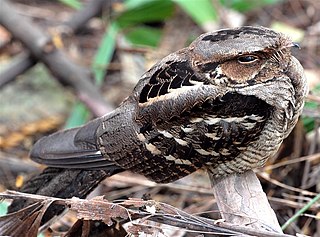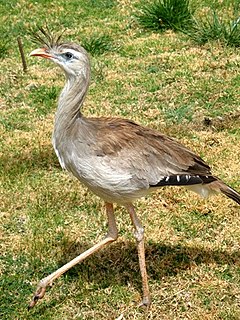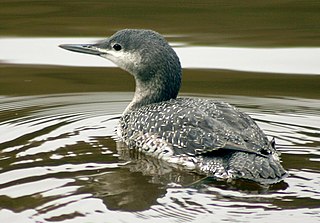Related Research Articles

A passerine is any bird of the order Passeriformes, which includes more than half of all bird species. Sometimes known as perching birds or songbirds, passerines are distinguished from other orders of birds by the arrangement of their toes, which facilitates perching.

The Caprimulgiformes is an order of birds that includes a number of birds with global distribution. They are generally insectivorous and nocturnal. The order gets its name from the Latin for "goat-milker", an old name based on an erroneous view of the European nightjar's feeding habits. As a clade, this group is known as Strisores.

The Coraciiformes are a group of usually colourful birds including the kingfishers, the bee-eaters, the rollers, the motmots, and the todies. They generally have syndactyly, with three forward-pointing toes, though in many kingfishers one of these is missing.

The Old World babblers or Timaliidae are a family of mostly Old World passerine birds. They are rather diverse in size and coloration, but are characterised by soft fluffy plumage. These are birds of tropical areas, with the greatest variety in Southeast Asia and the Indian subcontinent. The timaliids are one of two unrelated groups of birds known as babblers, the other being the Australasian babblers of the family Pomatostomidae.

The mesites (Mesitornithidae) are a family of birds that are part of a clade (Columbimorphae) that include Columbiformes and Pterocliformes. They are smallish flightless or near flightless birds endemic to Madagascar. They are the only family with more than two species in which every species is threatened.

Tityridae is family of suboscine passerine birds found in forest and woodland in the Neotropics. The 45 species in this family were formerly spread over the families Tyrannidae, Pipridae and Cotingidae. As yet, no widely accepted common name exists for the family, although tityras and allies and tityras, mourners and allies have been used. They are small to medium-sized birds. Under current classification, the family ranges in size from the buff-throated purpletuft, at 9.5 cm (3.7 in) and 10 grams, to the masked tityra, at up to 24 cm (9.5 in) and 88 grams. Most have relatively short tails and large heads.

Neoaves is a clade that consists of all modern birds with the exception of Paleognathae and Galloanserae. Almost 95% of the roughly 10,000 known species of modern birds belong to the Neoaves.
The order Falconiformes is represented by the extant family Falconidae and a handful of enigmatic Paleogene species. Traditionally, the other bird of prey families Cathartidae, Sagittariidae (secretarybird) Pandionidae (ospreys), Accipitridae (hawks) were classified in Falconiformes. A variety of comparative genome analysis published since 2008, however, found that falcons are part of a clade of birds called Australaves, which also includes seriemas, parrots and passerines. Within Australaves falcons are more closely related to the parrot-passerine clade (Psittacopasserae), which together they form the clade Eufalconimorphae. The hawks and vultures occupy a basal branch in the clade Afroaves in their own clade Accipitrimorphae, closer to owls and woodpeckers.

Psittacopasserae is a taxon of birds consisting of the Passeriformes and Psittaciformes (parrots). Per Ericson and colleagues, in analysing genomic DNA, revealed a lineage comprising Passerines, Psittaciformes and Falconiformes. The group was proposed following an alignment of nuclear intron sequences by Shannon Hackett et al. in 2008, it was formally named in a 2011 Nature Communications article by Alexander Suh and other authors working with Jürgen Schmitz's group, based on genetic analysis of the insertion of retroposons into the genomes of key avian lineages over the course of evolution during the Mesozoic Era.

Cariamiformes is an order of primarily flightless birds that has existed for over 60 million years. The group includes the family Cariamidae (seriemas) and the extinct families Phorusrhacidae, Bathornithidae, Idiornithidae and Ameghinornithidae. Though traditionally considered a suborder within Gruiformes, both morphological and genetic studies show that it belongs to a separate group of birds, Australaves, whose other living members are Falconidae, Psittaciformes and Passeriformes.

Eufalconimorphae is a proposed clade of birds, consisting of passerines, parrots, falcons, caracaras, and forest falcons. It has whole-genome DNA support. The Eufalconimorphae is noted to produce aerodynamic force during the upstroke of flight to help create a vertical flight pattern.

Australaves is a recently defined clade of birds, consisting of the Eufalconimorphae as well as the Cariamiformes. They appear to be the sister group of Afroaves. As in the case of Afroaves, the most basal clades have predatory extant members, suggesting this was the ancestral lifestyle; however, some researchers like Darren Naish are skeptical of this assessment, since some extinct representatives such as the herbivorous Strigogyps led other lifestyles. Basal parrots and falcons are at any rate vaguely crow-like and probably omnivorous.

Corvoidea is a superfamily of birds in the order of Passeriformes.

Telluraves is a recently defined clade of birds defined by their arboreality. Based on most recent genetic studies, the clade unites a variety of bird groups, including the australavians as well as the afroavians. They appear to be the sister group of a newly defined clade centered on Aequornithes.

Eurypygimorphae or Phaethontimorphae is a clade of birds that contains the orders Phaethontiformes (tropicbirds) and Eurypygiformes recovered by genome analysis. The relationship was first identified in 2013 based on their nuclear genes. Historically these birds were placed at different parts of the tree, with tropicbirds in Pelecaniformes and the kagu and sunbittern in Gruiformes. Some genetic analyses have placed the eurypygimorph taxa in the controversial and obsolete clade Metaves, with uncertain placement within that group. More recent molecular studies support their grouping together in Eurypygimorphae, which is usually recovered as the sister taxon to Aequornithes within Ardeae.

Ardeae is a clade of birds that contains Eurypygimorphae and Aequornithes, named in 2014 by genome analysis. Members of Eurypygimorphae were originally classified in the obsolete group Metaves, and Aequornithes were classified as the sister taxon to Musophagiformes or Gruiformes.

Columbimorphae is a clade discovered by genome analysis that includes birds of the orders Columbiformes, Pterocliformes (sandgrouse), and Mesitornithiformes (mesites). Previous analyses had also recovered this grouping, although the exact relationships differed. Some studies indicated a sister relationship between sandgrouse and pigeons while other studies favored a sister grouping of mesites and sandgrouse instead.

Columbaves is a clade that contains Columbimorphae and Otidimorphae discovered by genomic analysis by Prum et al. (2015). This conflicts with the Columbea and Otidae hypotheses which Mirandornithes are the sister taxon to Columbimorphae and Cypselomorphae the sister taxon to Otidimorphae, respectively, found by Jarvis et al. (2014). Neither hypothesis supports the two subdivisions of Metaves and Coronoaves as previous studies had found.

Vanescaves is a probable clade of strisorean birds that include the clades Steatornithiformes, Nyctibiiformes, Podargiformes (frogmouths), and Apodimorphae. Some molecular studies do support the grouping of these birds, others offer conflicting positions of the non-apodimorphaean strisoreans. In 2019 the authors Chen et al. performed a combined analysis using 2289 ultra-conserved elements [UCEs], 117 morphological characters from extant and fossil taxa found support in this clade. The authors then proposed to name this group, which its meaning is Latin for "vanish birds" in reference to the disparate nature of their geographic distribution, as well as to the poem "A Route of Evanescence" by the American poet Emily Dickinson which features a hummingbird as the main subject. In 2020 Chen & Field named the two major subclades of this group, with Sedentaves and Letornithes for their crown-groups.

Muscicapida is a clade of birds in the order Passeriformes. Oliveros, C.H. et al. (2019) suggested a gondwanan migration of this lineage from Australia to Eurasia.
References
- ↑ Ridgway, Robert; Friedmann, Herbert (1911-01-01). The Birds of North and Middle America: A Descriptive Catalog of the Higher Groups, Genera, Species, and Subspecies of Birds Known to Occur in North America, from the Arctic Lands to the Isthmus of Panama, the West Indies and Other Islands of the Caribbean Sea, and the Galapagos Archipelago. U.S. Government Printing Office. p. 297. ISBN 9780598370709.
- ↑ Ericson, P. G. P.; Anderson, C. L.; Britton, T.; Elzanowski, A.; Johansson, U. S.; Källersjö, M.; Ohlson, J. I.; Parsons, T. J.; Zuccon, D.; Mayr, G. (2006). "Diversification of Neoaves: integration of molecular sequence data and fossils". Biology Letters. 2 (4): 543–547. doi:10.1098/rsbl.2006.0523. PMC 1834003 . PMID 17148284.
- ↑ Boyd, John H. "TiF Checklist: COLUMBEA: Mirandornithes, Columbimorphae". jboyd.net. Retrieved 29 August 2017.
- ↑ Boyd, John H. "TiF Checklist: BASAL AUSTRALAVES: Cariamiformes, Falconiformes & Psittaciformes". jboyd.net. Retrieved 29 August 2017.
- ↑ Hackett, S.J.; Kimball, R.T.; Reddy, S.; Bowie, R.C.K.; Braun, E.L.; Braun, M.J.; Chojnowski, J.L.; Cox, W.A.; Han, K-L.; Harshman, J.; Huddleston, C.J.; Marks, B.D.; Miglia, K.J.; Moore, W.S.; Sheldon, F.H.; Steadman, D.W.; Witt, C.C.; Yuri, T. (2008). "A phylogenomic study of birds reveals their evolutionary history". Science . 320 (5884): 1763–1767. Bibcode:2008Sci...320.1763H. doi:10.1126/science.1157704. PMID 18583609. S2CID 6472805.
- ↑ Kuhl, H.; Frankl-Vilches, C.; Bakker, A.; Mayr, G.; Nikolaus, G.; Boerno, S.T.; Klages, S.; Timmermann, B.; Gahr, M. (2020). "An unbiased molecular approach using 3′-UTRs resolves the avian family-level tree of life". Molecular Biology and Evolution. 38 (msaa191): 108–127. doi: 10.1093/molbev/msaa191 . PMC 7783168 . PMID 32781465.